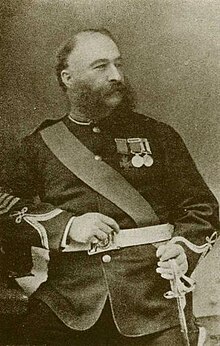John Lucas (VC)
John Lucas | |
|---|---|
 | |
| Born | 1826 Bagenalstown, Ireland |
| Died | 4 March 1892 (aged 65–66) Dublin, Ireland |
| Buried | St James's Church and Graveyard, Dublin, Ireland |
| Allegiance | |
| Branch | |
| Rank | Sergeant Major |
| Unit | 40th (2nd Somersetshire) Regiment of Foot |
| Battles / wars | New Zealand Wars |
| Awards | Victoria Cross New Zealand War Medal Long Service and Good Conduct Medal [1] |
John Lucas VC (1826 – 4 March 1892) was a British Army soldier and a recipient of the Victoria Cross, the highest award for gallantry in the face of the enemy that can be awarded to British and Commonwealth forces. He was the first member of the 40th Foot to be awarded the VC.[2]
Early life
[edit]Lucas as born in Clashganny, Bagenalstown, County Carlow in 1826.
Victoria Cross
[edit]Colour Sergeant John Lucas, 40th (2nd Somersetshire) Regiment of Foot (later part of the South Lancashire Regiment – The Prince of Wales's Volunteers), was approximately 35 years old:
On the 18th of March, 1861, Colour-Serjeant Lucas acted as Sergeant of a party of the 40th Regiment, employed as skirmishers to the right of No. 7, Redoubt, and close to the Huirangi Bush, facing the left of the positions occupied by the natives. At about 4 o'clock P.M., a very heavy and well-directed fire was suddenly opened upon them from the Bush, and the high ground on the left. Three men being wounded simultaneously, two of them mortally, assistance was called for in order to have them carried to the rear: a file was immediately sent, but had scarcely arrived, when one of them fell, and Lieutenant Rees was wounded at the same time. Colour-Serjeant Lucas, under heavy fire from the rebels, who were not more than thirty yards distant, immediately ran up to the assistance of this Officer, and sent one man with him to the rear. He then took charge of the arms belonging to the killed and wounded men, and maintained his position until the arrival of supports under Lieutenants Gibson and Whelan.[3]
The action was part of the First Taranaki War during the New Zealand Wars. This campaign started over a disputed land sale at Waitara. In December 1860 British forces under Major General Thomas Simson Pratt carried out sapping operations against a major Māori defensive line called Te Arei ("The barrier") on the west side of the Waitara River and inland from Waitara, which was barring the way to the historic hill pā of Pukewairangi. The 18 March was the last day before a truce was declared.[4] [5]
Later career and life
[edit]By then promoted to sergeant-major, Lucas received his Victoria Cross from Lieutenant-General Duncan Cameron at Ellerslie Racecourse in Auckland, on 2 October 1862.[2]
He died in Dublin on 29 February 1892 and is buried there in St. James churchyard.
See also
[edit]References
[edit]- ^ Smythies, Raymond Henry Raymond (1894), Historical Records of the 40Th (2nd Somersetshire) Regiment, Now 1st Battalion the Prince of Wales's Volunteers (South Lancashire Regiment) from its Formation, in 1777, to 1893, Devonport: Subscribers, p. 583, ISBN 9785878066778
- ^ a b Kippin, Mick (June 2022). "Saved by a VC Winner". Orders & Medals Research Society Journal. 61 (2): 145.
- ^ "No. 22531". The London Gazette. 19 July 1861. p. 2962.
- ^ Harper, Glyn; Richardson, Colin (2006). In the Face of the Enemy. Auckland: HarperCollins. p. 36. ISBN 1869505220.
- ^ Belich, James (1986). The New Zealand Wars: and the Victorian Interpretation of Racial Conflict. Auckland: Auckland University Press. p. 75. ISBN 186940002X.
External links
[edit]- Location of grave and VC medal (Dublin)
- 1826 births
- 1892 deaths
- 19th-century Irish people
- Irish soldiers in the British Army
- People from Bagenalstown
- Irish recipients of the Victoria Cross
- British military personnel of the New Zealand Wars
- New Zealand Wars recipients of the Victoria Cross
- South Lancashire Regiment soldiers
- British Army recipients of the Victoria Cross
- Military personnel from County Carlow
- Burials in Dublin (county)
- 19th-century British Army personnel
